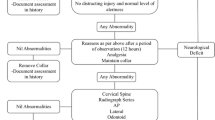Abstract
Introduction:
Clearing the cervical spine in polytrauma patients still presents a challenge for the trauma team. The risk of an overlooked cervical spine injury is substantial since these patients show painful and lifethreatening injuries to one or more organ systems so that clinical examination is usually not reliable. A generally approved guideline to assess the cervical spine in polytrauma patients might significantly reduce delays in diagnosis, but a consistent protocol for evaluating the cervical spine has not been uniformly accepted or performed by clinicians. The aim of this study was to assess the safety and efficacy of the diagnostic algorithm at this trauma center and to propose a possible consensus of the optimal method for clearing the cervical spine in polytrauma patients.
Materials and Methods:
This study retrospectively analyzed the clinical records of all polytrauma patients with cervical spine injuries (n = 118) who were admitted to this level-I trauma center between 1980 and 2004. All patients were assessed following the trauma algorithm of our unit (modified by Nast-Kolb). Standard radiological evaluation of the cervical spine consisted of a single lateral view or a three-view cervical spine series. Further radiological examinations (functional flexion/extension views, oblique views, CT-scan, MRI) were performed by clinical suspicion of an injury or when indicated by the standard radiographs.
Results:
Correct diagnosis was made in 107 patients (91%) during primary trauma evaluation, whereas in 11 patients (9%) our approach to clear the cervical spine failed to detect significant cervical spine injuries: In six cases skeletal injuries were missed because only a lateral view of the cervical spine was performed during primary trauma evaluation and in one case because a three-view cervical spine series did not show the extent of the injury. In four cases discoligamentous injuries were missed despite complete sets of standard radiographs and a CT-scan, but missing functional flexion/ extension views.
Conclusion:
For assessment of the cervical spine in poly-trauma patients we recommend a three-view trauma series as minimum to clear the cervical spine and the more liberal use of CT-scan as standard diagnostic tool in a specific subset of patients with clinically suspected cervical spine injuries and significant trauma history. In those patients also, passive functional flexion/ extension views should be considered as obligate in later stages of diagnostic algorithm.
Similar content being viewed by others
Author information
Authors and Affiliations
Corresponding author
Rights and permissions
About this article
Cite this article
Platzer, P., Thalhammer, G., Jaindl, M. et al. Clearing the Cervical Spine in Polytrauma Patients: Current Standards in Diagnostic Algorithm. Eur J Trauma 32, 570–575 (2006). https://doi.org/10.1007/s00068-006-5093-6
Received:
Accepted:
Published:
Issue Date:
DOI: https://doi.org/10.1007/s00068-006-5093-6




